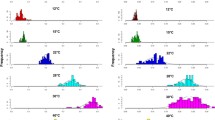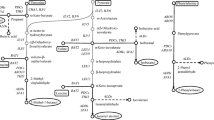Abstract
In the industrial yeast biomass production process, cells undergo an oxidative and other stresses which worsen the quality of the produced biomass. The overexpression of the thioredoxin codifying gene TRX2 in a wine Saccharomyces cerevisiae strain increases resistance to oxidative stress and industrial biomass production yield. We observed that variations in the TRX2 gene dose in wine yeast strains are relevant to determine the fermentative capacity throughout the industrial biomass production process. So, we studied the molecular changes using a transcriptomic approach under these conditions. The results provide an overview of the different metabolic pathways affected during industrial biomass production by TRX2 gene manipulation. The oxidative stress-related genes, like those related with the glutathione metabolism, presented outstanding variations. The data also allowed us to propose new thioredoxin targets in S. cerevisiae, such as hexokinase 2, with relevance for industrial fermentation performance.




Similar content being viewed by others
References
Ahuatzi D, Herrero P, de la CT, Moreno F (2004) The glucose-regulated nuclear localization of hexokinase 2 in Saccharomyces cerevisiae is Mig1-dependent. J Biol Chem 279:14440–14446
Ashe MP, De Long SK, Sachs AB (2000) Glucose depletion rapidly inhibits translation initiation in yeast. Mol Biol Cell 11:833–848
Avery AM, Avery SV (2001) Saccharomyces cerevisiae expresses three phospholipid hydroperoxide glutathione peroxidases. J Biol Chem 276:33730–33735
Boisnard S, Lagniel G, Garmendia-Torres C, Molin M, Boy-Marcotte E, Jacquet M, Toledano MB, Labarre J, Chedin S (2009) H2O2 activates the nuclear localization of Msn2 and Maf1 through thioredoxins in Saccharomyces cerevisiae. Eukaryot Cell 8:1429–1438
Cohen BA, Pilpel Y, Mitra RD, Church GM (2002) Discrimination between paralogs using microarray analysis: application to the Yap1p and Yap2p transcriptional networks. Mol Biol Cell 13:1608–1614
de la Cera HP, Moreno-Herrero F, Chaves RS, Moreno F (2002) Mediator factor Med8p interacts with the hexokinase 2: implication in the glucose signalling pathway of Saccharomyces cerevisiae. J Mol Biol 319:703–714
De Winde JH, Crauwels M, Hohmann S, Thevelein JM, Winderickx J (1996) Differential requirement of the yeast sugar kinases for sugar sensing in establishing the catabolite-repressed state. Eur J Biochem 241:633–643
Delaunay A, Pflieger D, Barrault MB, Vinh J, Toledano MB (2002) A thiol peroxidase is an H2O2 receptor and redox-transducer in gene activation. Cell 111:471–481
Demasi AP, Pereira GA, Netto LE (2006) Yeast oxidative stress response. Influences of cytosolic thioredoxin peroxidase I and of the mitochondrial functional state. FEBS J 273:805–816
DeRisi JL, Iyer VR, Brown PO (1997) Exploring the metabolic and genetic control of gene expression on a genomic scale. Science 278:680–686
Fernandes L, Rodrigues-Pousada C, Struhl K (1997) Yap, a novel family of eight bZIP proteins in Saccharomyces cerevisiae with distinct biological functions. Mol Cell Biol 17:6982–6993
Finley D, Ozkaynak E, Varshavsky A (1987) The yeast polyubiquitin gene is essential for resistance to high temperatures, starvation, and other stresses. Cell 48:1035–1046
Gasch AP, Spellman PT, Kao CM, Carmel-Harel O, Eisen MB, Storz G, Botstein D, Brown PO (2000) Genomic expression programs in the response of yeast cells to environmental changes. Mol Biol Cell 11:4241–4257
Gietz RD, Schiestl RH, Willems AR, Woods RA (1995) Studies on the transformation of intact yeast cells by the LiAc/SS-DNA/PEG procedure. Yeast 11:355–360
Gómez-Pastor R, Pérez-Torrado R, Cabiscol E, Matallana E (2010a) Transcriptomic and proteomic insights of the wine yeast biomass propagation process. FEMS Yeast Res 10:878–884
Gómez-Pastor R, Pérez-Torrado R, Cabiscol E, Ros J, Matallana E (2010b) Reduction of oxidative cellular damage by overexpression of the thioredoxin TRX2 gene improves yield and quality of wine yeast dry active biomass. Microb Cell Fact 9:9
Gómez-Pastor R, Pérez-Torrado R, Matallana E (2010c) Improving yield of industrial biomass propagation by increasing the Trx2p dosage. Bioengineered Bugs 1:352–353
Grant CM (2008) Metabolic reconfiguration is a regulated response to oxidative stress. J Biol 7:1
Güldener U, Heck S, Fielder T, Beinhauer J, Hegemann JH (1996) A new efficient gene disruption cassette for repeated use in budding yeast. Nucleic Acids Res 24:2519–2524
Hasan R, Leroy C, Isnard AD, Labarre J, Boy-Marcotte E, Toledano MB (2002) The control of the yeast H2O2 response by the Msn2/4 transcription factors. Mol Microbiol 45:233–241
He XJ, Mulford KE, Fassler JS (2009) Oxidative stress function of the Saccharomyces cerevisiae Skn7 receiver domain. Eukaryot Cell 8:768–778
Herrero P, Galíndez J, Ruiz N, Martínez-Campa C, Moreno F (1995) Transcriptional regulation of the Saccharomyces cerevisiae HXK1, HXK2 and GLK1 genes. Yeast 11:137–144
Holmgren A (1989) Thioredoxin and glutaredoxin systems. J Biol Chem 264:13963–13966
Inoue Y, Matsuda T, Sugiyama K, Izawa S, Kimura A (1999) Genetic analysis of glutathione peroxidase in oxidative stress response of Saccharomyces cerevisiae. J Biol Chem 274:27002–27009
Izawa S, Maeda K, Sugiyama K, Mano J, Inoue Y, Kimura A (1999) Thioredoxin deficiency causes the constitutive activation of Yap1, an AP-1-like transcription factor in Saccharomyces cerevisiae. J Biol Chem 274:28459–28465
Koc A, Mathews CK, Wheeler LJ, Gross MK, Merrill GF (2006) Thioredoxin is required for deoxyribonucleotide pool maintenance during S phase. J Biol Chem 281:15058–15063
Kohrer K, Domdey H (1991) Preparation of high-molecular-weight RNA. Methods Enzymol 194:398–405
Kuge S, Jones N (1994) YAP1 dependent activation of TRX2 is essential for the response of Saccharomyces cerevisiae to oxidative stress by hydroperoxides. EMBO J 13:655–664
Kuge S, Jones N, Nomoto A (1997) Regulation of yAP-1 nuclear localization in response to oxidative stress. EMBO J 16:1710–1720
Kumar JK, Tabor S, Richardson CC (2004) Proteomic analysis of thioredoxin-targeted proteins in Escherichia coli. Proc Natl Acad Sci U S A 101:3759–3764
Martínez-Pastor MT, Marchler G, Schuller C, Marchler-Bauer A, Ruis H, Estruch F (1996) The Saccharomyces cerevisiae zinc finger proteins Msn2p and Msn4p are required for transcriptional induction through the stress response element (STRE). EMBO J 15:2227–2235
Mason JT, Kim SK, Knaff DB, Wood MJ (2006) Thermodynamic basis for redox regulation of the Yap1 signal transduction pathway. Biochemistry 45:13409–13417
Montrichard F, Alkhalfioui F, Yano H, Vensel WH, Hurkman WJ, Buchanan BB (2009) Thioredoxin targets in plants: the first 30 years. J Proteomics 72:452–474
Muller EG (1991) Thioredoxin deficiency in yeast prolongs S phase and shortens the G1 interval of the cell cycle. J Biol Chem 266:9194–9202
Özcan S, Johnston M (1999) Function and regulation of yeast hexose transporters. Microbiol Mol Biol Rev 63:554–569
Pérez-Torrado R, Bruno-Barcena JM, Matallana E (2005) Monitoring stress-related genes during the process of biomass propagation of Saccharomyces cerevisiae strains used for wine making. Appl Environ Microbiol 71:6831–6837
Pérez-Torrado R, Gómez-Pastor R, Larsson C, Matallana E (2009) Fermentative capacity of dry active wine yeast requires a specific oxidative stress response during industrial biomass growth. Appl Microbiol Biotechnol 81:951–960
Praekelt UM, Meacock PA (1990) HSP12, a new small heat shock gene of Saccharomyces cerevisiae: analysis of structure, regulation and function. Mol Gen Genet 223:97–106
Puig S, Ramón D, Pérez-Ortin JE (1998) Optimized method to obtain stable food-safe recombinant wine yeast strains. J Agri Food Chem 46:1689–1693
Querol A, Barrio E, Huerta T, Ramon D (1992) Molecular monitoring of wine fermentations conducted by active dry yeast strains. Appl Environ Microbiol 58:2948–2953
Ralser M, Wamelink MM, Kowald A, Gerisch B, Heeren G, Struys EA, Klipp E, Jakobs C, Breitenbach M, Lehrach H, Krobitsch S (2007) Dynamic rerouting of the carbohydrate flux is key to counteracting oxidative stress. J Biol 6:10
Randez-Gil F, Sanz P, Entian KD, Prieto JA (1998) Carbon source-dependent phosphorylation of hexokinase PII and its role in the glucose-signaling response in yeast. Mol Cell Biol 18:2940–2948
Rodriguez A, de la Cera T, Herrero P, Moreno F (2001) The hexokinase 2 protein regulates the expression of the GLK1, HXK1 and HXK2 genes of Saccharomyces cerevisiae. Biochem J 355:625–631
Rodrigues-Pousada CA, Nevitt T, Menezes R, Azevedo D, Pereira J, Amaral C (2004) Yeast activator proteins and stress response: an overview. FEBS Lett 567:80–85
Rose M, Albig W, Entian KD (1991) Glucose repression in Saccharomyces cerevisiae is directly associated with hexose phosphorylation by hexokinases PI and PII. Eur J Biochem 199:511–518
Schwob E, Nasmyth K (1993) CLB5 and CLB6, a new pair of B cyclins involved in DNA replication in Saccharomyces cerevisiae. Genes Dev 7:1160–1175
Shima J, Kuwazaki S, Tanaka F, Watanabe H, Yamamoto H, Nakajima R, Tokashiki T, Tamura H (2005) Identification of genes whose expressions are enhanced or reduced in baker's yeast during fed-batch culture process using molasses medium by DNA microarray analysis. Int J Food Microbiol 102:63–71
Trotter EW, Grant CM (2002) Thioredoxins are required for protection against a reductive stress in the yeast Saccharomyces cerevisiae. Mol Microbiol 46:869–878
Veal EA, Ross SJ, Malakasi P, Peacock E, Morgan BA (2003) Ybp1 is required for the hydrogen peroxide-induced oxidation of the Yap1 transcription factor. J Biol Chem 278:30896–30904
Yu FX, Chai TF, He H, Hagen T, Luo Y (2010) Thioredoxin-interacting protein (Txnip) gene expression: sensing oxidative phosphorylation status and glycolytic rate. J Biol Chem 285:25822–25830
Acknowledgments
This work has been supported by grants AGL 2005-00508 and AGL 2008-00060 from the Spanish Ministry of Education and Science (MEC). R.G-P. was a predoctoral fellow of the I3P program from the CSIC (Spanish National Research Council). We thank the Proteomic and Transcriptomic Service of the Institute of Agrochemistry and Food Technology (IATA, CSIC) for their support in the transcriptomic analysis.
Author information
Authors and Affiliations
Corresponding author
Electronic supplementary material
Below is the link to the electronic supplementary material.
ESM 1
(DOC 91 kb)
Rights and permissions
About this article
Cite this article
Gómez-Pastor, R., Pérez-Torrado, R. & Matallana, E. Modification of the TRX2 gene dose in Saccharomyces cerevisiae affects hexokinase 2 gene regulation during wine yeast biomass production. Appl Microbiol Biotechnol 94, 773–787 (2012). https://doi.org/10.1007/s00253-011-3738-9
Received:
Revised:
Accepted:
Published:
Issue Date:
DOI: https://doi.org/10.1007/s00253-011-3738-9




